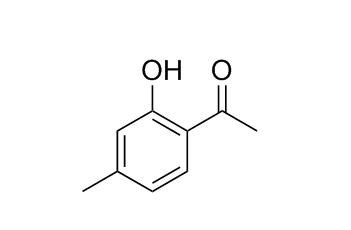2'-Hydroxy-4'-methylacetophenone
2'-Hydroxy-4'-methylacetophenone has acaricidal activity, it could be used in the preparation of 4’-methyl-2’-[(p-tolylsulfonyl) oxy] acetophenone.
Inquire / Order:
manager@chemfaces.com
Technical Inquiries:
service@chemfaces.com
Tel:
+86-27-84237783
Fax:
+86-27-84254680
Address:
1 Building, No. 83, CheCheng Rd., Wuhan Economic and Technological Development Zone, Wuhan, Hubei 430056, PRC
Providing storage is as stated on the product vial and the vial is kept tightly sealed, the product can be stored for up to
24 months(2-8C).
Wherever possible, you should prepare and use solutions on the same day. However, if you need to make up stock solutions in advance, we recommend that you store the solution as aliquots in tightly sealed vials at -20C. Generally, these will be useable for up to two weeks. Before use, and prior to opening the vial we recommend that you allow your product to equilibrate to room temperature for at least 1 hour.
Need more advice on solubility, usage and handling? Please email to: service@chemfaces.com
The packaging of the product may have turned upside down during transportation, resulting in the natural compounds adhering to the neck or cap of the vial. take the vial out of its packaging and gently shake to let the compounds fall to the bottom of the vial. for liquid products, centrifuge at 200-500 RPM to gather the liquid at the bottom of the vial. try to avoid loss or contamination during handling.
Saudi Pharmaceutical Journal2023, 31(12):101829
Toxicol In Vitro.2019, 59:161-178
Int J Mol Med.2016, 37(2):501-8
Am J Chin Med.2022, 1-20.
Int J Mol Sci.2023, 24(24):17589.
Patanjali Research Foundation2024, ssrn.4807357
Comput Biol Chem.2019, 83:107096
Food Research International2016, 106-113
Fitoterapia.2024, 175:105955.
J.Acta Agriculturae Scandinavica2017, 571-575
Related and Featured Products
J Agric Food Chem. 2012 Apr 11;60(14):3606-11.
Acaricidal toxicity of 2'-hydroxy-4'-methylacetophenone isolated from Angelicae koreana roots and structure-activity relationships of its derivatives.[Pubmed:
22429095 ]
The acaricidal activities of 2'-Hydroxy-4'-methylacetophenone derived from Angelica koreana roots and its derivatives against Dermatophagoides farinae, Dermatophagoides pteronyssinus, and Tyrophagus putrescentiae were examined by vapor phase and contact toxicity bioassays.
METHODS AND RESULTS:
In the vapor phase toxicity bioassay, 2'-methylacetophenone (1.25 μg/cm(2)) was 8.0 times more toxic against D. farinae than benzyl benzoate (10.00 μg/cm(2)), followed by 3'-methylacetophenone (1.26 μg/cm(2)), 4'-methylacetophenone (1.29 μg/cm(2)), 2'-Hydroxy-4'-methylacetophenone (1.75 μg/cm(2)), and 2'-hydroxy-5'-methylacetophenone (1.96 μg/cm(2)). In the contact toxicity bioassay, 3'-methylacetophenone (0.58 μg/cm(2)) was 17.24 times more effective against D. farinae than benzyl benzoate (7.52 μg/cm(2)), followed by 2'-methylacetophenone (0.64 μg/cm(2)), 2'-Hydroxy-4'-methylacetophenone (0.76 μg/cm(2)), 4'-methylacetophenone (0.77 μg/cm(2)), and 2'-hydroxy-5'-methylacetophenone (1.16 μg/cm(2)). The acaricidal activities of 2'-Hydroxy-4'-methylacetophenone derivatives against D. pteronyssinus and T. putrescentiae were similar to those against D. farinae.
CONCLUSIONS:
In terms of structure-activity relationships, acaricidal activity against the three mite species changed with the introduction of hydroxyl and methyl functional groups onto the acetophenone skeleton. Furthermore, some of 2'-Hydroxy-4'-methylacetophenone derivatives could be useful for natural acaricides against three mite species.



